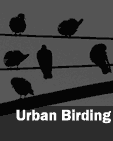

|
Editor's Notes |
For more wonderful pictures of this famous Manhattanite, and of other NYC subjects, avian and otherwise, visit Lincoln Karim's www.palemale.com. Fig. 1 shows Pale Male's nest, on an apartment building on Fifth Avenue in the 70's, in which he has raised numerous families, with several wives. Fig. 3 shows him with "a very brave house finch". Fig. 4 is the telescope used by Mr. Karim to capture some of his shots; if you visit Central Park's boat pond at this time of year, you will likely see several telescopes set up and trained on the nest, and be given an opportunity to look through one, if you want. "Pale Male" first appeared in Manhattan ten years ago, as an naive youth. His subsequent triumphs and tragedies are engagingly chronicled in Marie Winn's best-seller, "Red-tails In Love" (one critic called it "Dr. Zhivago with feathers"), and on her website. Following is Ms. Winn's introduction of Pale Male, from her book:
Visit www.mariewinn.com for updated reports on Pale Male, and on urban birding!
|
All content Copyright 2003 on behalf of its creators; please obtain permission for anything besides private, noncommercial use.
This page requires a 6.0+ browser for the pictures/text to display correctly.